Family Nurse Practice: Role, Theory, and Conflict Report
VerifiedAdded on 2023/01/20
|10
|937
|32
Report
AI Summary
This report provides an overview of the role of Family Nurse Practitioners (FNPs), emphasizing their collaborative and autonomous functions in delivering family-focused healthcare services. It explores Kolcaba's Comfort Theory, a middle-range nursing theory, and its significance in promoting patient well-being through ease, relief, and transcendence. The report highlights the importance of holistic care, caring interventions, and institutional integrity within the framework of the theory. It addresses the issue of conflict of interest faced by FNPs and how adherence to the Comfort Theory can help prioritize patient needs and tailor treatment plans. The conclusion underscores the FNPs' role in long-term patient wellness, the challenges they encounter, and the benefits of applying the Comfort Theory to address these challenges.
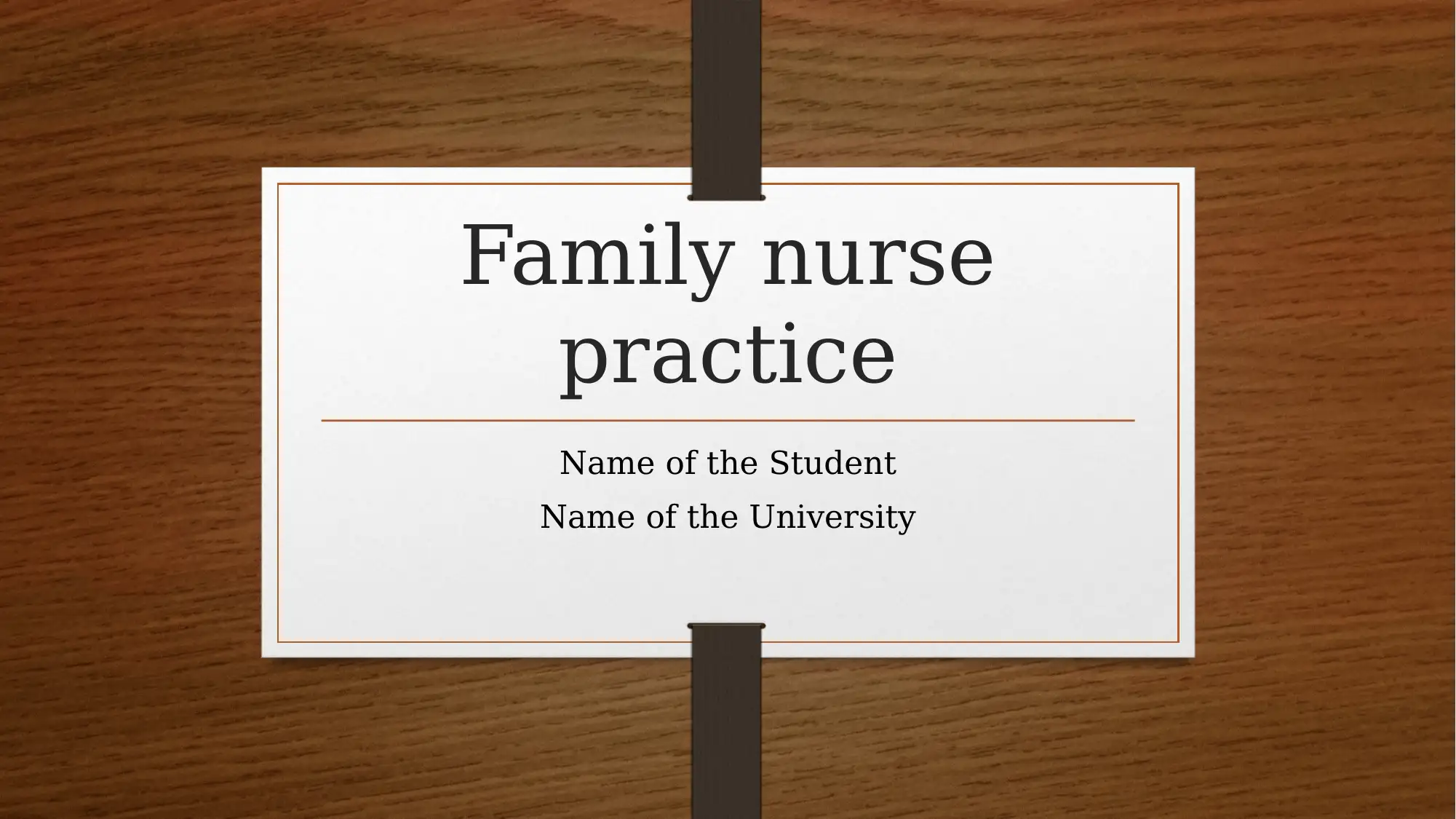
Family nurse
practice
Name of the Student
Name of the University
practice
Name of the Student
Name of the University
Paraphrase This Document
Need a fresh take? Get an instant paraphrase of this document with our AI Paraphraser
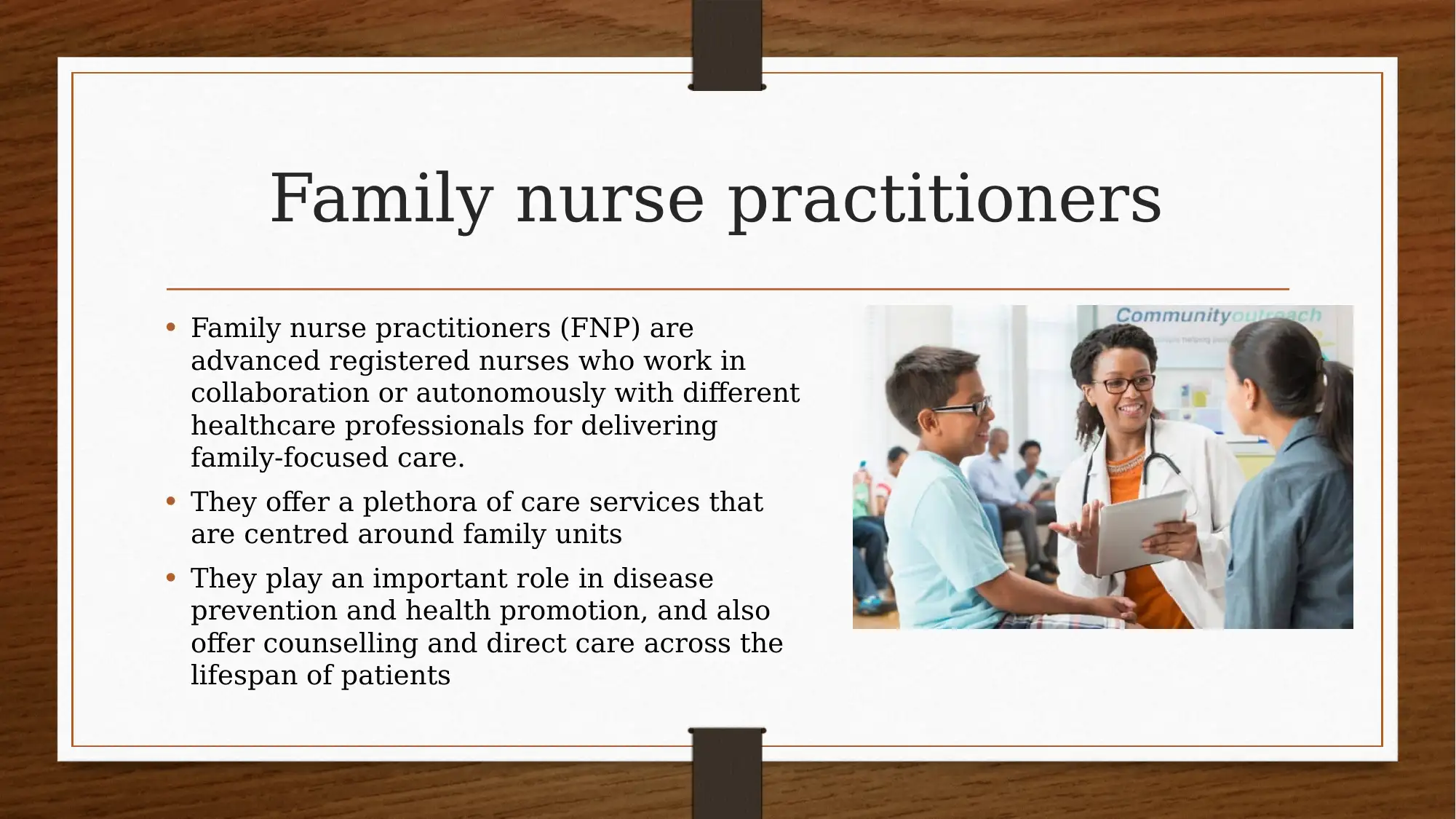
Family nurse practitioners
• Family nurse practitioners (FNP) are
advanced registered nurses who work in
collaboration or autonomously with different
healthcare professionals for delivering
family-focused care.
• They offer a plethora of care services that
are centred around family units
• They play an important role in disease
prevention and health promotion, and also
offer counselling and direct care across the
lifespan of patients
• Family nurse practitioners (FNP) are
advanced registered nurses who work in
collaboration or autonomously with different
healthcare professionals for delivering
family-focused care.
• They offer a plethora of care services that
are centred around family units
• They play an important role in disease
prevention and health promotion, and also
offer counselling and direct care across the
lifespan of patients

Nursing theory
• Theory of Comfort has been postulated by Kolcaba in
1990s (Krinsky, Murillo & Johnson, 2014).
• It is a middle-range theory that is can be applied to the
domains of education, health practice, and research.
• It holds the potential of placing comfort as an essential
prerequisite of healthcare
• It considers comfort as an immediate outcome of health
and social care.
• Theory of Comfort has been postulated by Kolcaba in
1990s (Krinsky, Murillo & Johnson, 2014).
• It is a middle-range theory that is can be applied to the
domains of education, health practice, and research.
• It holds the potential of placing comfort as an essential
prerequisite of healthcare
• It considers comfort as an immediate outcome of health
and social care.
⊘ This is a preview!⊘
Do you want full access?
Subscribe today to unlock all pages.

Trusted by 1+ million students worldwide

Nursing theory
• The model explains the concept of comfort in
the form of a central need of all human beings
for ease, relief, or transcendence rising from
stressful health situations
• Comfort has been found to enhance the health-
seeking behaviour among affected patients,
nurses and family members (Kolcaba et al.,
2015).
• It also focuses on the domains of holistic care,
caring, intervening variables, and institutional
integrity.
• The model explains the concept of comfort in
the form of a central need of all human beings
for ease, relief, or transcendence rising from
stressful health situations
• Comfort has been found to enhance the health-
seeking behaviour among affected patients,
nurses and family members (Kolcaba et al.,
2015).
• It also focuses on the domains of holistic care,
caring, intervening variables, and institutional
integrity.
Paraphrase This Document
Need a fresh take? Get an instant paraphrase of this document with our AI Paraphraser
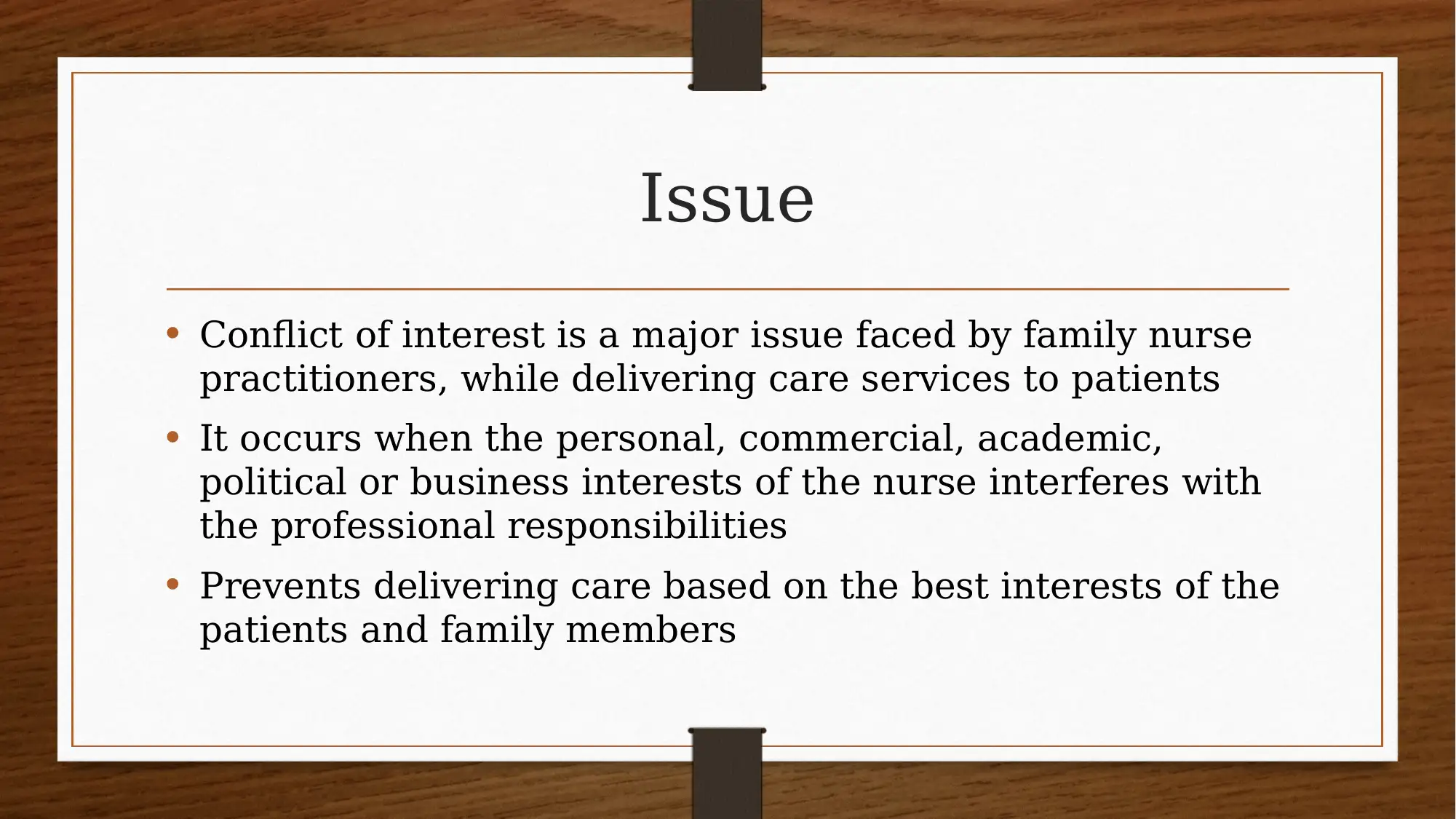
Issue
• Conflict of interest is a major issue faced by family nurse
practitioners, while delivering care services to patients
• It occurs when the personal, commercial, academic,
political or business interests of the nurse interferes with
the professional responsibilities
• Prevents delivering care based on the best interests of the
patients and family members
• Conflict of interest is a major issue faced by family nurse
practitioners, while delivering care services to patients
• It occurs when the personal, commercial, academic,
political or business interests of the nurse interferes with
the professional responsibilities
• Prevents delivering care based on the best interests of the
patients and family members
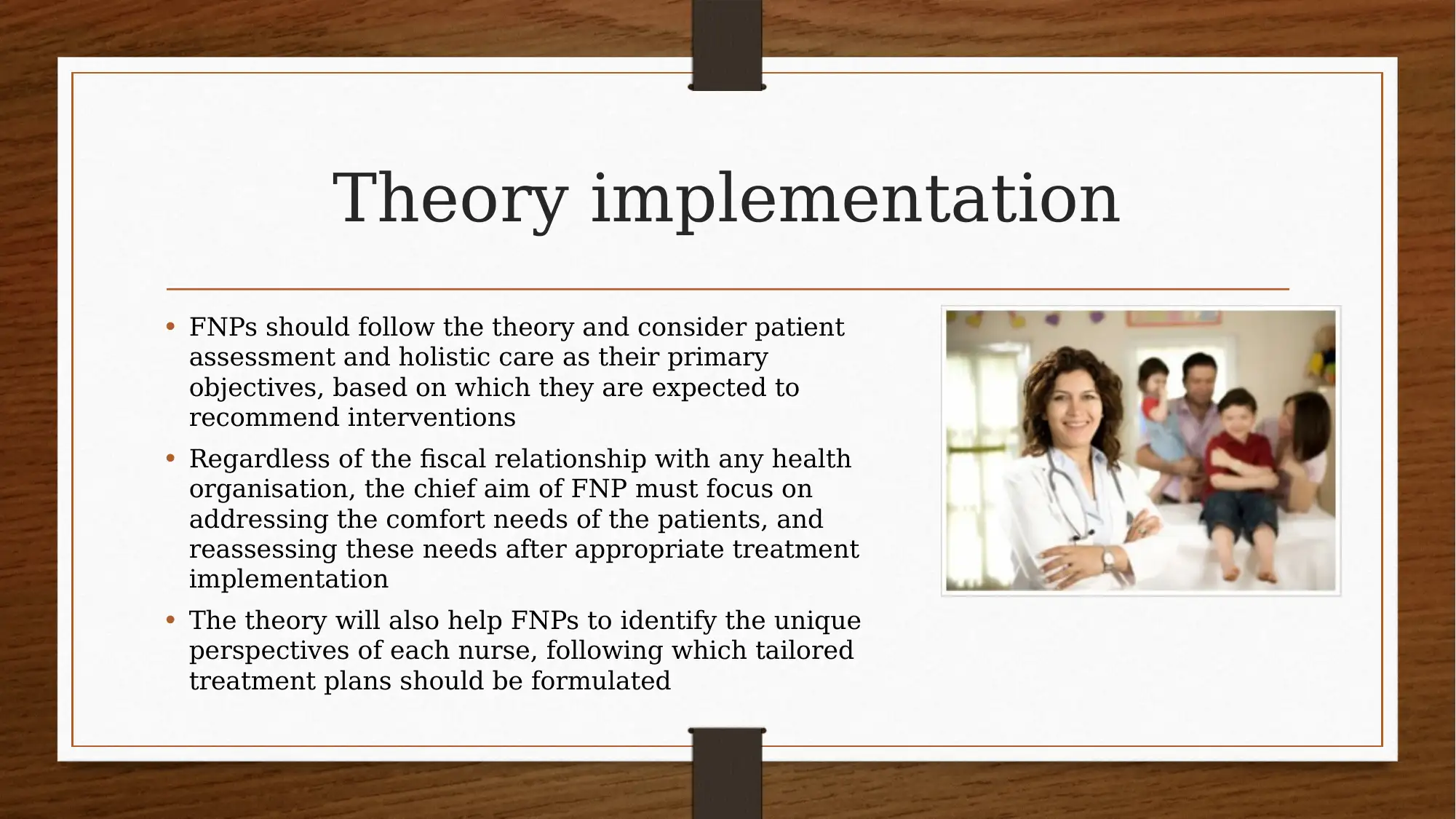
Theory implementation
• FNPs should follow the theory and consider patient
assessment and holistic care as their primary
objectives, based on which they are expected to
recommend interventions
• Regardless of the fiscal relationship with any health
organisation, the chief aim of FNP must focus on
addressing the comfort needs of the patients, and
reassessing these needs after appropriate treatment
implementation
• The theory will also help FNPs to identify the unique
perspectives of each nurse, following which tailored
treatment plans should be formulated
• FNPs should follow the theory and consider patient
assessment and holistic care as their primary
objectives, based on which they are expected to
recommend interventions
• Regardless of the fiscal relationship with any health
organisation, the chief aim of FNP must focus on
addressing the comfort needs of the patients, and
reassessing these needs after appropriate treatment
implementation
• The theory will also help FNPs to identify the unique
perspectives of each nurse, following which tailored
treatment plans should be formulated
⊘ This is a preview!⊘
Do you want full access?
Subscribe today to unlock all pages.

Trusted by 1+ million students worldwide
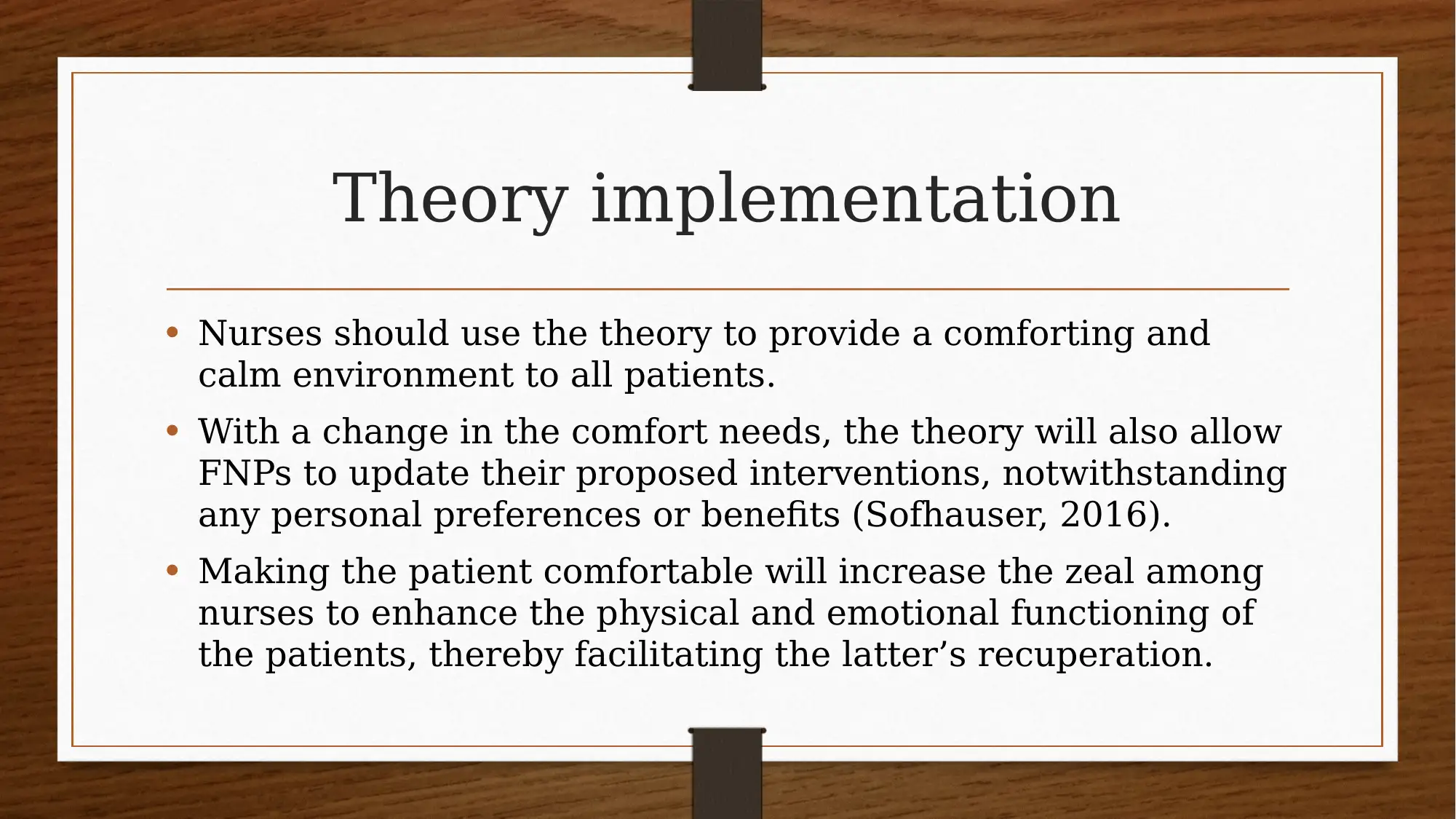
Theory implementation
• Nurses should use the theory to provide a comforting and
calm environment to all patients.
• With a change in the comfort needs, the theory will also allow
FNPs to update their proposed interventions, notwithstanding
any personal preferences or benefits (Sofhauser, 2016).
• Making the patient comfortable will increase the zeal among
nurses to enhance the physical and emotional functioning of
the patients, thereby facilitating the latter’s recuperation.
• Nurses should use the theory to provide a comforting and
calm environment to all patients.
• With a change in the comfort needs, the theory will also allow
FNPs to update their proposed interventions, notwithstanding
any personal preferences or benefits (Sofhauser, 2016).
• Making the patient comfortable will increase the zeal among
nurses to enhance the physical and emotional functioning of
the patients, thereby facilitating the latter’s recuperation.
Paraphrase This Document
Need a fresh take? Get an instant paraphrase of this document with our AI Paraphraser

Conclusion
• FNPs are trained to work with adults and children in
family settings
• They maintain wellness and health of patients in the long
run
• They might face the issue of conflict of interest while
providing care services
• Adoption of Kolkaba Comfort theory will help in
addressing this issue
• FNPs are trained to work with adults and children in
family settings
• They maintain wellness and health of patients in the long
run
• They might face the issue of conflict of interest while
providing care services
• Adoption of Kolkaba Comfort theory will help in
addressing this issue

References
Aksoy Derya, Y., & Pasinlioğlu, T. (2017). The effect of nursing care based on comfort theory on women's postpartum comfort levels after caesarean
sections. International journal of nursing knowledge, 28(3), 138-144. https://doi.org/10.1111/2047-3095.12122
Dahrouge, S., Muldoon, L., Ward, N., Hogg, W., Russell, G., & Taylor-Sussex, R. (2014). Roles of nurse practitioners and family physicians in
community health centres. Canadian Family Physician, 60(11), 1020-1027. Retrieved from http://www.cfp.ca/content/60/11/1020.full
Egger-Rainer, A., Trinka, E., Höfler, J., & Dieplinger, A. M. (2017). Epilepsy monitoring–The patients' views: A qualitative study based on Kolcaba's
Comfort Theory. Epilepsy & Behavior, 68, 208-215. https://doi.org/10.1016/j.yebeh.2016.11.005
Joyner, M. J., & Paneth, N. (2015). Seven questions for personalized medicine. Jama, 314(10), 999-1000. doi:10.1001/jama.2015.7725
Kolcaba, K. A. T. H. A. R. I. N. E. (2015). Katherine Kolcaba’s comfort theory. Nursing theories and nursing practice, 381-392. https
://books.google.co.in/books?hl=en&lr=&id=oMjXBgAAQBAJ&oi=fnd&pg=PA381&dq=theory+of+comfort+kolcaba&ots=-w7Qk-gBiV&sig
=1WfLCl5MfdVRChbdtbCOgmCmItc#v=onepage&q=theory%20of%20comfort%20kolcaba&f=false
Krinsky, R., Murillo, I., & Johnson, J. (2014). A practical application of Katharine Kolcaba's comfort theory to cardiac patients. Applied Nursing
Research, 27(2), 147-150. https://doi.org/10.1016/j.apnr.2014.02.004
Muth, C. C. (2017). Conflict of interest in medicine. Jama, 317(17), 1812-1812. doi:10.1001/jama.2017.4044
Pinto, S., Caldeira, S., Martins, J. C., & Rodgers, B. (2017). Evolutionary analysis of the concept of comfort. Holistic nursing practice, 31(4), 243-
252. doi: 10.1097/HNP.0000000000000217
Seyedfatemi, N., Rafii, F., Rezaei, M., & Kolcaba, K. (2014). Comfort and hope in the preanesthesia stage in patients undergoing surgery. Journal of
PeriAnesthesia Nursing, 29(3), 213-220. https://doi.org/10.1016/j.jopan.2013.05.018
Sofhauser, C. (2016). Intention in nursing practice. Nursing science quarterly, 29(1), 31-34. https://doi.org/10.1177%2F0894318415614629
Aksoy Derya, Y., & Pasinlioğlu, T. (2017). The effect of nursing care based on comfort theory on women's postpartum comfort levels after caesarean
sections. International journal of nursing knowledge, 28(3), 138-144. https://doi.org/10.1111/2047-3095.12122
Dahrouge, S., Muldoon, L., Ward, N., Hogg, W., Russell, G., & Taylor-Sussex, R. (2014). Roles of nurse practitioners and family physicians in
community health centres. Canadian Family Physician, 60(11), 1020-1027. Retrieved from http://www.cfp.ca/content/60/11/1020.full
Egger-Rainer, A., Trinka, E., Höfler, J., & Dieplinger, A. M. (2017). Epilepsy monitoring–The patients' views: A qualitative study based on Kolcaba's
Comfort Theory. Epilepsy & Behavior, 68, 208-215. https://doi.org/10.1016/j.yebeh.2016.11.005
Joyner, M. J., & Paneth, N. (2015). Seven questions for personalized medicine. Jama, 314(10), 999-1000. doi:10.1001/jama.2015.7725
Kolcaba, K. A. T. H. A. R. I. N. E. (2015). Katherine Kolcaba’s comfort theory. Nursing theories and nursing practice, 381-392. https
://books.google.co.in/books?hl=en&lr=&id=oMjXBgAAQBAJ&oi=fnd&pg=PA381&dq=theory+of+comfort+kolcaba&ots=-w7Qk-gBiV&sig
=1WfLCl5MfdVRChbdtbCOgmCmItc#v=onepage&q=theory%20of%20comfort%20kolcaba&f=false
Krinsky, R., Murillo, I., & Johnson, J. (2014). A practical application of Katharine Kolcaba's comfort theory to cardiac patients. Applied Nursing
Research, 27(2), 147-150. https://doi.org/10.1016/j.apnr.2014.02.004
Muth, C. C. (2017). Conflict of interest in medicine. Jama, 317(17), 1812-1812. doi:10.1001/jama.2017.4044
Pinto, S., Caldeira, S., Martins, J. C., & Rodgers, B. (2017). Evolutionary analysis of the concept of comfort. Holistic nursing practice, 31(4), 243-
252. doi: 10.1097/HNP.0000000000000217
Seyedfatemi, N., Rafii, F., Rezaei, M., & Kolcaba, K. (2014). Comfort and hope in the preanesthesia stage in patients undergoing surgery. Journal of
PeriAnesthesia Nursing, 29(3), 213-220. https://doi.org/10.1016/j.jopan.2013.05.018
Sofhauser, C. (2016). Intention in nursing practice. Nursing science quarterly, 29(1), 31-34. https://doi.org/10.1177%2F0894318415614629
⊘ This is a preview!⊘
Do you want full access?
Subscribe today to unlock all pages.

Trusted by 1+ million students worldwide

Thank you!
1 out of 10
Related Documents
Your All-in-One AI-Powered Toolkit for Academic Success.
+13062052269
info@desklib.com
Available 24*7 on WhatsApp / Email
![[object Object]](/_next/static/media/star-bottom.7253800d.svg)
Unlock your academic potential
Copyright © 2020–2025 A2Z Services. All Rights Reserved. Developed and managed by ZUCOL.





